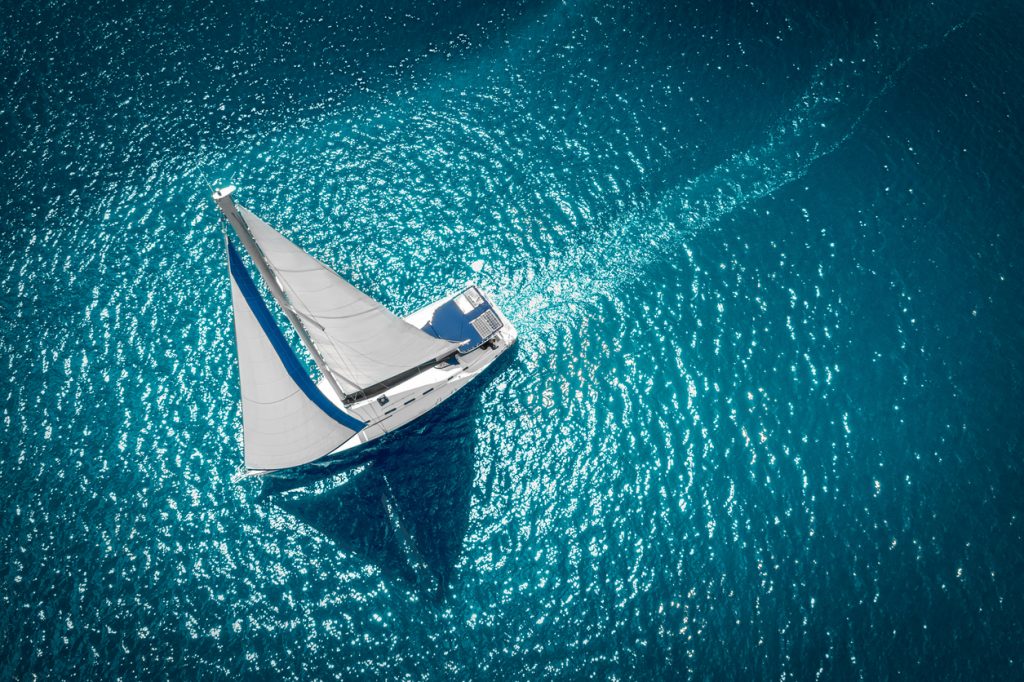Proper sail care and securing sailboat insurance are important parts of overall seamanship and protecting your investment. By being aware of the factors that fatigue sails and cause them to wear and tear, you can prevent yourself from having to do any unnecessary repairs.
Flogging
Flogging is the quickest way to damage a set of sails, especially membrane sails made from high-tech fibers, as they do not do well when they are repeatedly bent, which is exactly what happens when a sail is allowed to flog. Eventually, delicate fibers will slowly fatigue.
Flogging can be simply letting your mainsail flap in the breeze as you motor back to the mooring. Drop the main while motoring or sheet it on tight to prevent it from flapping. Avoid creating additional apparent wind by motoring at a higher speed than necessary.
Another way flogging occurs is not trimming properly. If the lead position on the headsail, for instance, is too far aft, the leech will twist off and flap. Ensure the leech line is properly tightened and use the trim line. This simple sail care technique will prevent unnecessary fatigue and promote a longer lifespan for your sail.
UV Degradation
Ultraviolet (UV) light has a slow and deleterious effect on all fabrics, but some are more sensitive than others.
No matter the fabric, all cruising headsails should have a protective UV cover along the leech and foot so that when the sail is left rolled up on the headstay, the UV strip is outermost and completely protects the sail.
A genoa cover can also be used and is especially useful with membrane cruising headsails, where you don’t want to add a low-tech UV sunshield to the trailing edge of a high-tech sail.
The same applies to boom covers. Any time the mainsail is lowered and lashed to the boom it should be covered.
Consider a mainsail cover that includes a foil liner, made from the same material that is used for making space blankets and completely blocks the sun’s harmful rays.
Chafe
All sails rub against the rig and lifelines, and this area of constant friction will soon develop into a hole that could lead to the sail ripping. Consider adding spreader patches to both your headsail and mainsail. Each time you tack, the headsail gets dragged across the spreader ends, gradually weakening the sail in that area, so these areas need to be especially protected.
Over-Trimming a Sail
Many cruising boats have an electric winch aboard, which are so powerful they remain intact until something breaks, which, more likely than not, will be the sail.
If you’re hoisting a sail, hand crank the last few feet, so that you can feel when it has reached the end. Also consider adding full-hoist marks to your halyards. On a calm day at the dock, hoist the sail all the way up. Then, when it is at max hoist, mark the halyard against some corresponding point.
Moisture, Mildew, Maintenance
Most modern fabrics are treated with antifungal agents. You can even have the sail dipped into an anti-UV and anti-fungal solution.
Caring for your sails at the end of a sailing season is just as important as taking care of the sail while you are out sailing. First and foremost, make sure that you rinse the sail with fresh water, as salt will crystallize and damage delicate fibers.
To clean sails, use a mild detergent like dishwashing liquid. For oil and grease, use an automotive degreaser like Simple Green. After cleaning let it dry completely to avoid mildew from forming between the folded layers.
About Mariners Insurance
Mariners General Insurance Group was founded in 1959 to protect boat owners and marine business clients. We are marine insurance experts and insure boats worldwide – in every ocean on the planet. Marine insurance is critical if you own a boat or nautical business. Trust the professionals with all of your Boat Insurance needs – trust Mariners Insurance. Call us at (888) 402-5018 any time you have questions or concerns about insurance for your vessel or marine business.



